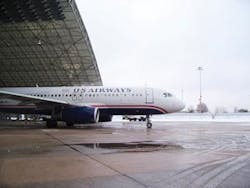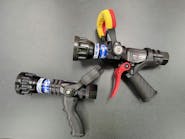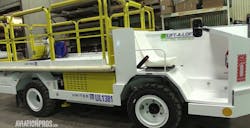Of unremitting concern within the ground support industry is the winter precipitation that accumulates on aircraft creating a reduction in lift and controllability at take-off which can cause almost certain catastrophic results. According to a report by Transport Canada, until the mid 1990s, the commercial aviation industry suffered an average of one major accident per winter where icing on the ground was the major contributing cause.
Precipitating Change
Historically, in preparation for take-off under winter storm conditions, aircraft surfaces have been cleaned of precipitation with deicing fluid and protected against further accumulation by applying an anti-icing fluid. However, the planning and scheduling of the deicing and anti-icing activities at airports is an exigent and challenging part of the airport departure process during the winter months.
“The season of 1995-96 was an unusually bad winter for JFK and the entire region,” says Robert Junge, manager, airport operations division for JFK International Airport. “The incredible number of storms and significant accumulation of snow highlighted our own inefficiencies as an airport with its unique structure of eight individual terminals and the aircrafts’ shared use of common easement alley ways.” The time required to perform the deicing on large aircraft blocked start-up diamonds and alley ways. Many aircraft already deiced ran out of holdover time due to the taxiway congestion. Aircraft on the taxiways waiting to get to the gate were blocked by aircraft being deiced in the alley ways waiting to depart.
The extended holdover times, flight delays and passenger frustrations during that winter season lead to the scrutiny of the airport’s deicing operations. This resulted in the development of a deicing task force which included several consultants as well as a joint effort with the airlines. “At the worst point of the 95-96 season, we not only deiced in all of the alley ways, throats and ramps; we also gave up aeronautical pavement — taxiway sections, to the tune of seven different locations set up for ad hoc deicing,” Junge says. “This had a detrimental effect on the capacity to move aircraft.” In 1998, the task force produced a report outlining the current deicing operations, the inefficient practices and the viable alternatives for deicing aircraft on a “global airport performance” level rather than an individual airline level at JFK.
Centralized Yet Costly Solutions
According to Junge, after reviewing the report, the alternatives had a significant price tag, but more important was the fact they had to meet most, if not all of the criteria for JFK. Many of the recommendations included a coordinated central deicing location, resulting in removing the deicing process from individual ramps and freeing up alley ways for arrivals. “We are a big airport but we are strapped for under-utilized square footage,” Junge says. “A centralized deicing facility would not only free up real estate, but lessens the demand for glycol trucks, storage tanks, reclamation points and ATC coordination in the movement of aircraft on the airport.”
However, due to mild winters in 1999 and 2000, a considerable decline in passenger demand after 9/11 and the fiscal crisis with the airlines, airports and the industry as a whole; the deicing task force report was tabled.
During the winter seasons between 2003 and 2005, JFK proved the need for a central deicing facility after the Port Authority regained control of TWA’s Terminal 5, which had a large land mass available for alternate use. Because passenger demand was back up, JFK quickly turned the available acreage into a central deicing facility by designating taxi lanes and denoting deicing pads. There was enough space to simultaneously deice between 13 and 14 aircraft, depending on the size, while cueing up additional aircraft. “The good news … we actually didn’t lose a single departure slot or need to secondarily deice any of the aircraft due to the loss of holdover time or time spent on the taxiways during winter operations,” Junge claims. “The bad news … the use of the acreage was lost with the start of the areas rehabilitation for a new 26 gate terminal. This forced the airport community back to previous practices at a time when airport traffic was exploding to record numbers. It was a real shock to the airport community and to all of us.” JFK suffered miserably this past winter season during two unusually difficult ice storms that hit the entire northeast … a situation no one could have missed due to the extent of media coverage.
“It certainly woke us up to the realization that we needed to get back with the centralized deicing scheme,” Junge says. Solutions for where it would go ranged from taking over an abandoned cargo facility to building concrete pad structures at various locations on the airport, yet the options were fraught with difficulties in trying to meet the airport’s, airlines’ and FAA needs, not to mention the environmental regulations. “Obviously,” Junge states, “we were not only looking ahead for the capacity for the hourly flows at the airport but also for the environmental piece … glycol storage, replenishment and reclamation needs to be dealt with in an appropriate fashion.”
Mother Nature at It Again
Mother Nature is not only the reason for deicing but she also has her say on the environmental concerns created by the process. Commercial aviation and the U.S. military have been evaluating environmentally friendly alternatives for aircraft deicing operations for years. Though the events of 9/11 de-toured the immediacy of the concern, the goal remains the same — to prevent water and ground contamination while meeting flight requirements and enhancing safety.
Among the viable alternatives suggested in the deicing task force report, one in particular met the environmental criteria JFK was searching for—the InfraTek Radiant Deicing System, an infrared aircraft deicing system developed by Radiant Aviation Services. “While JFK was proving that Terminal 5 worked as a central deicing facility and the lost use of that property was going to hurt us, we also needed to show that infrared deicing as an emergent technology would benefit us,” Junge explains.
Already in operation at the Rhinelander-Oneida County Airport in Wisconsin and Newark International Airport, the system is the only FAA-approved, non-glycol based alternative to conventional deicing, according to Ian Sharkey, director Deicing Services, Radiant Aviation Services.
Infrared radiant heating has been used for decades in commercial and industrial workplaces ... and in the aviation industry, many aircraft service and overhaul hangers also use this method of heating. In recent years however, competition has forced airports and airlines to look carefully at all operations to reduce costs and increase efficiency. “High glycol consumption makes conventional glycol aircraft deicing inherently more expensive and environmental concerns are leading to an increased regulatory burden, forcing operators to reduce glycol emissions,” Sharkey says.
Build It and They Will Come
Fortunately for JFK, an old TWA maintenance hanger complex, part of a 52 acre a lease hold, reverted back to the Port Authority’s control. With certain proof of JFK’s deicing needs, the JFK team managed to preserve the two acre location with this lease hold for the development of the infrared deicing system. “We worked closely with the FAA and Radiant because the environmental improvement issues were extremely important, as well as the FAA’s Airport Improvement Program (AIP) funding available for such technologies and that show great promise,” Junge says. “We were able to procure a substantial amount of funding through the FAA … making this project possible at a time when our capital redevelopment most likely would not have had enough funds set aside in the time frame we were hoping to accomplish this.”
After patiently waiting for the right timing, JFK was able to build a central deicing facility on part of the property that did not involve the demolition of old buildings or the remediation of concrete. In addition, production costs were minimize and the facility was built in an area with growth potential.
“We were able to begin operations this past season … it may be the first time in the past 20 years I actually prayed for snow,” Junge concludes.
Infrared deicing is a formidable alternative to considered for deicing at airports, according to Junge. However, one of the issues they have to tackle now is to be careful not to “over subscribe” the system. If every airline at JFK realized how beneficial the new facility is and decided to use it, they wouldn’t be able to handle the entire airport. “Nonetheless, it was always described as a final lynch pin of our centralized deicing scheme,” Junge says.





